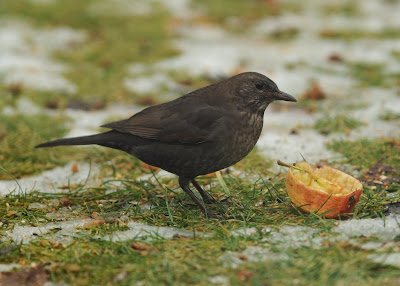It was also apparent how many infact showed these chevrons I mentioned on 2nd Dec, ie characteristics of the continental birds
I dont really know a great deal about Blackbirds, their variation and their moult but have attempted to make some sense of the individual birds.

According to BWP adult birds go through a complete post breeding moult and should be finished by November. Juveniles only undergo a partial moult and so will show contrasting old and new feathers.
Also according to BWP you can only safely age a 1st winter with pale tips to the retained coverts but am a bit confused as if all adults moult all feathers then surely a bird just showing two generations of feathers should be enough to age it??
This female has adult and juv greater coverts so presumably a first year. As I have been looking through these pics it seems that nearly all the first year birds consistently show around half new and half old greater coverts. A few chevrons on the lower belly/vent area on this one

Bird 2
Nice head pattern
Bird 6. First year male with lovely deep orange base to bill and eye ring
Bird 7 Classic first year male with new body feathers and old flight feathers. Quite well marked chevrons on this one. Eye ring a very pale yellow on this one and bill almost all grey
Bird 8 Not completely sure what is going on here! It appears to have 2 generations of greater coverts but close inspection reveals the inners to be rather worn and the outers looking in better condition. Also the pale areas at the tips are on the supposed replaced coverts so this along with the median coverts must just be pigment loss. It is certainly the most multi-coloured bird so far
Bird 9. Getting a bit out of my depth now. Looking at the greater coverts it looks as though they are all the same generation the pale one at the end looks like an alula feather? Also the inner feathers do look tattier than the outers which I suppose would be consistent if they were replaced first. It has also got 2 generations of tertials
Bird 10 Adult female? with same generation greater coverts although is that two generations of tail feathers?































